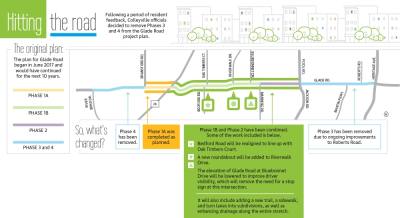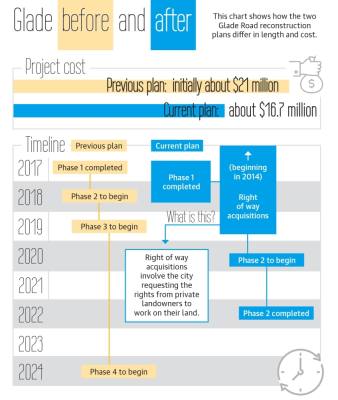The upgrades are also what caused Colleyville Mayor Richard Newton to run for and return to office in 2016 after a 10-year absence.
“The overall four-phase plan is too expensive,” Newton said he thought at the time.
With Newton at the helm, the plan for Glade changed significantly. The four-phase plan presented in 2014 has been revised to two phases.
The then-first phase, which reconstructed Glade from Bransford Road to SH 26 and added a sidewalk and trail, was finished in August 2018 and cost $1.7 million.
The remaining project will now reconstruct Glade from SH 26 to Pool Road and will be dealt with in one continuous phase costing about $15 million, officials said.
The goal is to make traffic flow more efficiently while keeping Glade at two lanes, Newton said. When the project is complete, Glade will also have enhanced drainage and safety.
“At the end of the day, it will be a really well-constructed road, safe for our residents,” Public Works Director Ray Silva-Reyes said.
Changing the project plan
In June 2017, Colleyville City Council members unanimously passed a resolution that eliminated Phases 3 and 4 of the Glade Road project from a previously approved design contract.
Those phases would have extended the project from Pool to Heritage Avenue and from River Bend Drive to Bransford Road; they were pulled from the project scope to address citizen concerns, Newton said.
In 2012, the city began exploring ways to improve safety and capacity issues on Glade. In 2014, a preliminary plan of improvements emerged, but some residents had issues with several of the details, Newton said.
The issues stemmed from residents wanting to preserve trees and the city wanting to take them out to make room for a sidewalk and trail system, Newton said.
Residents gathered enough signatures on a 2014 petition to trigger a May 2015 election on whether they should have more control over the project.
If passed, the resolution would have allowed the city to reconstruct Glade, but only after getting feedback from residents, Newton said. In the end, the resolution failed in a 2,908-2,320 vote.
Nevertheless, the project inspired Newton to campaign for mayor after being out of office for 10 years.
Once Newton was elected in 2016, Glade was one of his top priorities, he said. His goal was to find clear solutions to the issues he had heard.
“Right after I got in office, we must have gone through ... I can’t remember how many design iterations on Glade,” he said. “It took a while, and we had to spend some money, ... but in the end, we ended up where everybody was happy.”
There was no controversy in 2015 with Phase 1A of the project, which went from Bransford to SH 26 and was completed in 2017, Newton said.
Meanwhile, staff put together a plan that would effectively replace Phase 3 of the Glade project, which would have stretched from Pool Road to Heritage Avenue: The city set out to redo Roberts Road and add turn lanes for southbound traffic onto Glade.
“By addressing those things with the Roberts Road project, it really took care of all the issues that would have been in Phase 3,” Assistant City Manager Adrienne Lothery said.
Phase 4, which would have run from River Bend Drive to Bransford Road and included new pavement with left-turn lanes, was removed.
Phases combined
The two portions of the original project between SH 26 and Pool Road have been merged.
Colleyville City Council will award the project to a contractor in April, and then construction will begin.
Over the following 18-24 months, crews will install an 8-foot trail, a 5-foot sidewalk and a roundabout at Glade and Riverwalk Drive.
Work will also include realigning Bedford with Oak Timbers Court and lowering the elevation of Glade at Bluebonnet Drive to improve visibility. The lower elevation removes the need for stop signs at this intersection, officials said.
The Bluebonnet portion of the project will be funded with a $2 million federal grant. The purpose of the grant is to improve air quality, and by removing the stop sign and installing a roundabout, idling at Bluebonnet will be reduced, Silva-Reyes said.
Additionally, there are some pockets of Glade that are wide enough to install turn lanes. This should help people entering the neighborhoods off Glade during busy periods without holding up traffic, Newton said.
The project is estimated to cost $12.2 million minus the amount covered by the grant, Reyes said, and it is set to be funded through the Tax Increment Finance fund, which helps the city with quality-of-life improvements, such as road construction.
North Richland Hills resident Dennis Hunt said he often travels through Colleyville on Glade. He said he is looking forward to the road being easier to traverse.
“Any change to ease congestion is great,” he said. “I like to shop in Colleyville, but sometimes, it is hard to get there.”
Colleyville resident Roger Lee said he is concerned the project will encounter delays.
“[It] should have been completed years ago,” he said.
Assistant City Manager Mark Wood said the Glade project will help ensure the right infrastructure will be in place for the street’s long-term future, especially as more people use the Glade corridor.
“People are going to use Colleyville and Glade to cut through; we can’t stop that,” Wood said. “But hopefully, this project will facilitate that better.”
Ongoing work
While it might seem Glade construction had stalled, the city has worked for the past 2 1/2 years to acquire rights of way for the project and relocate utilities along the corridor.
The city has been working with each person involved with any right of way acquisitions along Glade to ensure they were being treated fairly, Newton said.
“We didn’t want anybody to feel this was a forceful decision,” he said.
With this effort wrapping up, construction on Glade will be launched just as the SH 26 widening project is being finished, Lothery said.
The downside, Newton said, is that residents will have to shift immediately from working around SH 26 construction to working around Glade construction.
“For the people that have to drive on Glade to get to their houses, the construction’s going to be a disruption,” he said.







